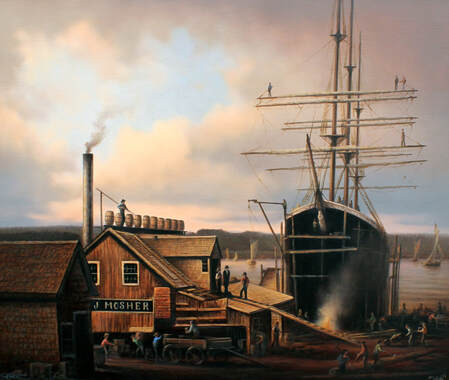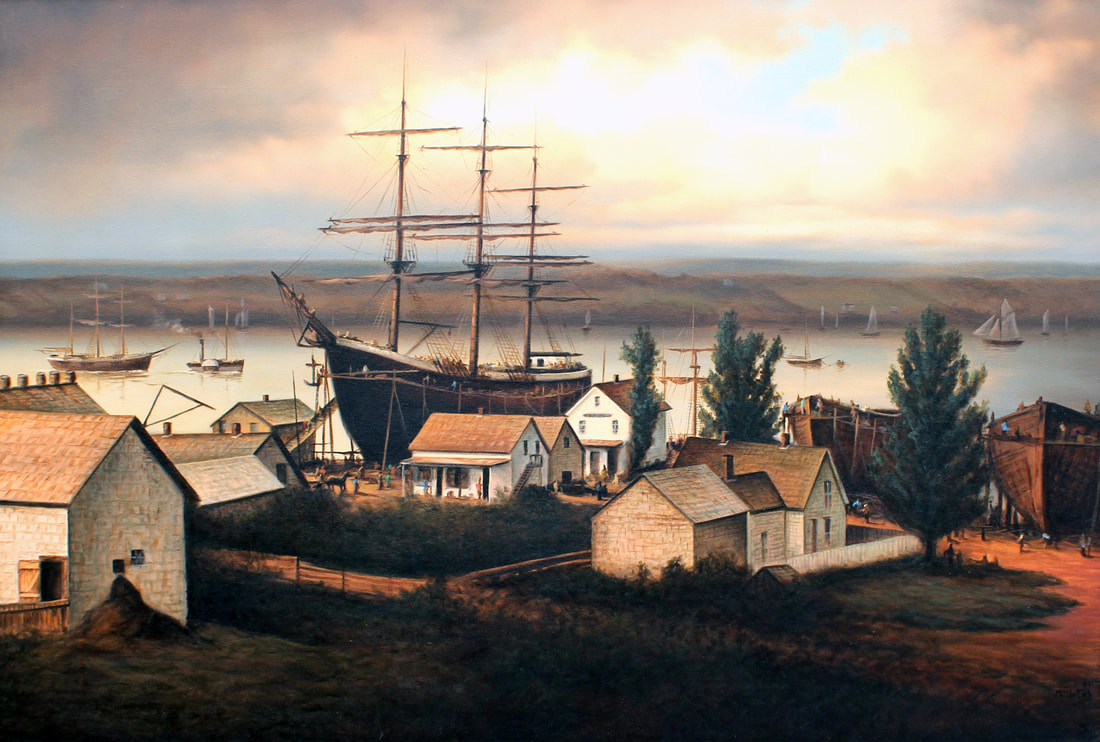
Did you know that for many years shipbuilding was a large industry in Newport? The first known ship constructed in the area was built in 1807 by Nicholas Mosher for the purpose of transporting gypsum. Nicholas was the son of James Mosher who came to Newport as a Planter from New England aboard the Lydia.
Two of his other sons, Jehu and George, had children and grandchildren who also took part in shipbuilding in Newport. In 1866 two men, John A. Harvie and William H. Mosher, took control of the shipyard originally belonging to the sons of George for business reasons. In its first year of operation, the Mosher and Harvie shipyard employed 35 workers at a payroll cost of $1,400.
Ship-building at these yards ended with the great-grandson of Nicholas Mosher, Thomas A. Mosher, in 1892. The Moshers also built bridges over the Avon and Cogmagun Rivers.
The shipyard which can be seen in these painting by David MacIntosh, was owned by the aforementioned Harvie and Mosher shipbuilders and launched all sorts of craft not far from the Avon River Heritage museum.
During the 1800s “Golden Age of Sail” the Avon River area became one of the great square-rigged wooden shipbuilding centers in Nova Scotia.
Hundreds of wooden vessels built along the Avon visited ports all over the world. Here in Newport Landing, over 165 vessels were built in two shipyards that were located on the lands of this park. Before this time, Mi’kmaq canoes and Acadian-made chaloupes plied the waters of the Avon River.
Many of the ships from this site and from around the Minas Basin were built for the firm of Andrew Gibson, a wealthy cotton merchant in Liverpool, England. Captain George Mounce, Sr. became a ship-building agent for Andrew Gibson, placing orders, supervising construction, and investing in the vessels. Captain Mounce built the first of the two large houses on the crest of the hill on Avondale Road. His two sons, Ralph and Thomas, competed in house- building, with one son expanding Captain Mounce’s house and the second son building a second, more elaborate house next door.
While ships were built for many purposes, from transporting gypsum to ferrying passengers, the growth in ship-building was largely driven by the needs of sugar production in the Caribbean. Locally-built ships carried salt fish to the West Indies, picked up sugar and its by-products (molasses and rum) to transport to England, and there loaded manufactured goods and salt for preserving fish. This Triangular Trade was built on the Transatlantic Slave Trade that saw over 12 million people enslaved and shipped from Africa to the Americas before this transport was halted in 1891.
Timber for local ships was mostly softwood harvested during winter. Some ships were built closer to the source of timber and then floated, without masts, down the Kennetcook or St. Croix Rivers at high tide. Reminders of the “Golden Age of Sail” can be found in the grand houses here, remains of wharves, and artifacts in the museums along the Avon River.
Two of his other sons, Jehu and George, had children and grandchildren who also took part in shipbuilding in Newport. In 1866 two men, John A. Harvie and William H. Mosher, took control of the shipyard originally belonging to the sons of George for business reasons. In its first year of operation, the Mosher and Harvie shipyard employed 35 workers at a payroll cost of $1,400.
Ship-building at these yards ended with the great-grandson of Nicholas Mosher, Thomas A. Mosher, in 1892. The Moshers also built bridges over the Avon and Cogmagun Rivers.
The shipyard which can be seen in these painting by David MacIntosh, was owned by the aforementioned Harvie and Mosher shipbuilders and launched all sorts of craft not far from the Avon River Heritage museum.
During the 1800s “Golden Age of Sail” the Avon River area became one of the great square-rigged wooden shipbuilding centers in Nova Scotia.
Hundreds of wooden vessels built along the Avon visited ports all over the world. Here in Newport Landing, over 165 vessels were built in two shipyards that were located on the lands of this park. Before this time, Mi’kmaq canoes and Acadian-made chaloupes plied the waters of the Avon River.
Many of the ships from this site and from around the Minas Basin were built for the firm of Andrew Gibson, a wealthy cotton merchant in Liverpool, England. Captain George Mounce, Sr. became a ship-building agent for Andrew Gibson, placing orders, supervising construction, and investing in the vessels. Captain Mounce built the first of the two large houses on the crest of the hill on Avondale Road. His two sons, Ralph and Thomas, competed in house- building, with one son expanding Captain Mounce’s house and the second son building a second, more elaborate house next door.
While ships were built for many purposes, from transporting gypsum to ferrying passengers, the growth in ship-building was largely driven by the needs of sugar production in the Caribbean. Locally-built ships carried salt fish to the West Indies, picked up sugar and its by-products (molasses and rum) to transport to England, and there loaded manufactured goods and salt for preserving fish. This Triangular Trade was built on the Transatlantic Slave Trade that saw over 12 million people enslaved and shipped from Africa to the Americas before this transport was halted in 1891.
Timber for local ships was mostly softwood harvested during winter. Some ships were built closer to the source of timber and then floated, without masts, down the Kennetcook or St. Croix Rivers at high tide. Reminders of the “Golden Age of Sail” can be found in the grand houses here, remains of wharves, and artifacts in the museums along the Avon River.
La région de la Rivière Avon a devenu un des grands centres de la construction navale en bois et avec les gréements en forme de carrés dans la Nouvelle-Écosse pendant le 19eme siècle et Newport Landing était l’endroit de le chantier navel Harvie et Mosher.
Saviez-vous que depuis de nombreuses années la construction navale était une grande industrie à Newport ? Le premier navire construit connu dans la région a été construit en 1807 par Nicholas Mosher dans le but de transporter du gypse. Nicholas était le fils de James Mosher qui est venu à Newport comme un « Planteur » de la Nouvelle-Angleterre à bord du Lydia. Deux de ses autres fils, Jehu et George, avaient des enfants et petits-enfants qui ont également pris part à la construction navale à Newport. À un certain moment dans les 1860 deux hommes, John Harvie et William Mosher, ont pris contrôle du chantier naval appartenant à l'origine aux fils de George, pour des raisons d'affaires. Le chantier naval qui peut être vu sur cette photographie a été possédé par les constructeurs Harvie et Mosher et a lancé toutes sortes d'embarcations pas loin d’Avon River Heritage Museum.
